from: Israel Finkelstein /
Neil A. Silberman: The Bible unearthed.
Archeology's New Vision of Ancient Israel and the Origin
of Its Sacred Texts; The Free Press, a division of Simon
& Schuster, Inc., 2001; German edition has got the
title "No trombones before Jericho" (orig. German:
"Keine Posaunen vor Jericho"): edition C.H.Beck oHG,
Munich 2002;
Here in this analysis is used the German version "Keine
Posaunen vor Jericho" of DTV, Munich 2004, second
edition of 2005. All page indications refer to the
German version. I hope the page numbers are not very
different.
Failed
"reconquest" - the Assyrian revenge - and king Manasseh
- and the One God Movement is spreading a story of a
Moses
705 B.C.
x
|
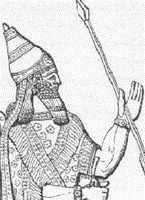
Sennacherib, ruler of
Assyria 704-681 B.C. provoking a new destiny
in the Middle East
|
The Assyrian successor of king Sargon II,
Sennacherib, is busy with rebellions in the East of the
Assyrian Empire. It seems that Assyria is destabilized
for a crash. The responsibles in Judah mean that this
would be the moment for a reconquest of northern Reich
of Israel (p.271).
Well, Assyria wants a stable Middle East (p.288) because
there are trade routes going from the bay of Beersheba
passing the highlands of Edom, and there are caravan
routes from the southern coastal plain to Arabia
(p.289). With stability the Arab trade is managed.
Rebellions will not be tolerated, not either in Judah,
because the Arab trade would be in danger (p.288).
Sennacherib defines Ninive as the new capital of Assyria
and has new palaces built [web01].
King Hezekiah means for his side that a religious reform
with the One God Movement could support the reconquest
of the ex northern Reich of Israel. But all in all the
trial of a reconquest is an absolute imprudence (p.292).
OT claims:
King Hezekiah - supported by Egypt - is said having made
an anti Assyrian coalition with others (2d book of Kings
18,21; 19,9).
or:
King Hezekiah is said having solved from the vassal
contract with Assyria (2d book of Kings 18,7).
But there is no rebellion described in the OT (p.275).
Propaganda for a "One God
Belief" by war
According to Finkelstein / Silberman this war also is a
pretext pushing through the "one god religion" in his
country (p.271).
OT claims: There are
preparations for defense against the Assyrian punitive
expedition
OT claims:
Before the Assyrian punitive expedition against the
conspiracy of Hezekiah is said having been prepared the
defense (p.275), with the construction of storehouses
for corn, oil and wine, with the construction of cattle
sheds for sheep and cattle (2d book of Chronicle
32,27-29).
Add to this
-- water supply for Jerusalem is saved covering springs
and the river by a roof (p.276) resp. the spring is
completed with an access by a new tunnel (2d book of
Kings 20,20) (p.277-278)
-- the town walls are said having been reinforced
-- there is said having been a general armament with
weapons and shields
-- Hezekiah is said having assured that with God will be
a victory against Assyria (2d book of Chronicle 32,2-8)
(p.276).
[Well, considering the Assyrian Empire this project of a
rebellion against Assyria is an absolute madness, and
the claim of a "punitive expedition" saving the trade
routs of the Arab trade seem to be reasonable].
Archeology confirms the
preparations for defense
-- for example a protective barrier of 16 meters of
thickness around the Jewish quarter of Jerusalem can be
stated
-- for the construction of this wall private houses are
destroyed which is mentioned also in OT by Isaiah
blaming the king for the destruction of the houses for
the construction of the wall (p.276)
-- archeology confirms an underground creek from the
spring of Gihon near Jerusalem at the ground of Kidron
valley outside of the town walls: There was dug a tunnel
from the spring to a pond which was 30 cm lower. Sioa
inscription at the southern end of the tunnel was
detected in 19th century telling about this project
(p.277).
"Hezekiah tunnel" for fresh water
supply in Jerusalem
|
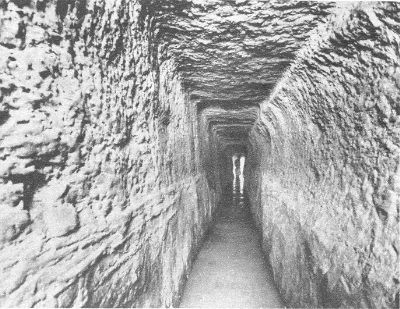
This tunnel was constructed for fresh water
supply in Jerusalem, dug under king Hezekiah
|
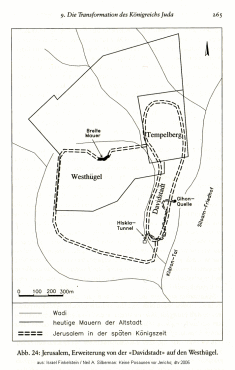
 Map of
Jerusalem with David's town, the spring of
Gihon, and the Hezekiah tunnel Map of
Jerusalem with David's town, the spring of
Gihon, and the Hezekiah tunnel
|
-- the town of Lachish receives tremendous defense
installations with a 6 chamber city gate, respectively
historians mean that the fortress which was assigned to
king Rehabeam first should be assigned to king Hezekiah
(p.278)
-- all stocks are organized in a centralized manner,
jars are produced in masses, with seals of the ceramics
workshops (p.278).
The Assyrian "punitive
expedition" in the kingdom of Judah - OT claims a
"mystery of Jerusalem"
-- according to OT the leading hand of God is in all
actions of king Hezekiah, and to his taste he will give
a reward or a punishment (p.273).
The siege of Jerusalem (king Sennacherib against king
Hezekiah) is described like this in the OT:
-- the Assyrian commanders are said having provoked the
defenders on the town wall of Jerusalem having mocked
the citizens and they are said having tried breaking
their courage taking into doubt Hezekiah's wisdom and
mocking his belief (p.273)
-- the Assyrian are said having reproached to the
citizens and representatives of Jerusalem that they had
lost the war already (2d book of Kings 28,28-35) (p.274)
-- supporting the moral texts about Hezekiah about the
"sins" of the northern Reich of Israel are presented and
repeated (p.273)
-- during the siege of Jerusalem prophet Isaiah is said
having calmed king Hezekiah with an oracle stating that
king Sennacherib will be confronted with a rumor and
will leave Jerusalem and will die in his own country by
the sword (2d book of Kings 19,6-7; 19,32-34) (p.274)
-- then in the following night an angel is said having
killed 185,000 men of the Assyrian army sieging
Jerusalem, and further is said that now king Sennacherib
had returned going home to Ninive and had been killed by
sword by his two sons Adrammelecht and Sarezer during a
religious service for god Nisroch (2d book of Kings
19,35-37) (p.274)
-- the saving of Jerusalem under king Hezekiah and the
destruction of the army of Sennacherib are said having
been actions of the hand of God (p.273) which were
performed thanks of piety of king Hezekiah (p.271)
-- also when all towns around Jerusalem were destroyed
by the Assyrian troops god JHWH is said having been the
key figure of the saving of the population - according
to AT (p.273)
-- Judah's belief to God is said having been reinforced
by the "miracle of Jerusalem" and king Hezekiah is said
having destroyed the places of sacrifices on the
"heights" (on the hill tops) (p.275).
x
|

 Sennacherib,
report of the military campaign against
Judah written in a clay prism. Today this is
in the British Museum. Sennacherib,
report of the military campaign against
Judah written in a clay prism. Today this is
in the British Museum.
|
The documents speak: Sennacherib's
report indicates the total destruction of Judah except
Jerusalem
-- Sennacherib's troops are sieging 46 Judean towns and
always win tanks to their "well constructed ramps of
earth" and "battering rams", add to this they are using
mines, gaps and pioneers (p.280)
-- the military campaign for the construction of the
rebellious Judah is precisely planned and is executed
from the fertile branches of the hilly country down to
Jerusalem (p.281)
-- for example the fortress of Azekah is taken by
assault and devastated (p.281).
And the mass killing of Assyrian soldiers does not
happen, God's hand is not at all helping but there comes
the Assyrian occupation of Jerusalem:
701 B.C.
Sennacherib's troops
defeating Judah
(S.271)
The prey of Sennacherib in
Judah according to his report
-- Sennacherib is making 200.150 prisoners of war, and
there is much cattle: "horses, mules, donkeys, camels,
cattle and small domestic animals (p.280)
-- the towns are plundered (p.281)
-- king Hezekiah in Jerusalem is reaching his end: He is
locked in his palace and the palace is walled at the end
(p.281).
[Addition:
King Sennacherib lets king Hezekiah live perhaps because
he wants to have a loyal vassal at the end].
Archeology: layers of ruins
confirming the Assyrian punitive expedition
The destruction of the towns by the military campaign
under Sennacherib form new hills of ruins (tells). These
are "horrible archaeological findings". Add to this
Finkelstein / Silberman mean that the number of
prisoners of war in Sennacherib's report was indicated
too high (p.281).
A wall relief in the palace
of Sennacherib in Ninive showing the battle of Lachish
Relief about the
siege and storming Lachish under king
Sennacherib - deportations
|
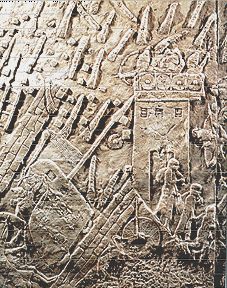
Relief of the siege of Lachish, finding in
Ninive
|
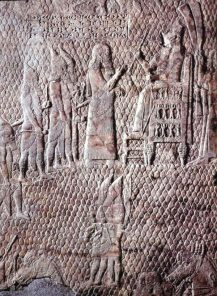
 Lachish:
Sennacherib receiving the surrendered Jewish
ruler, relief Lachish:
Sennacherib receiving the surrendered Jewish
ruler, relief
|
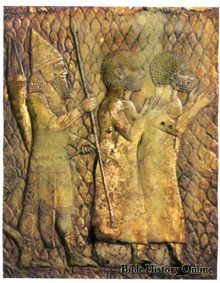
 Lachish:
After the siege Jews are prisoners, finding in
Ninive Lachish:
After the siege Jews are prisoners, finding in
Ninive
(www.bible-history.com)
|
This wall of reliefs which was excavated in
old Ninive is describing the fall of Lachish by
the army of king Sennacherib in pictures. The
population is seized at the end. Before the
siege of Jerusalem Sennacherib took 36 towns.
Today the relief is in the British Museum
[web02].
|
A mural relief in Sennacherib's palace of Ninive on the
wall of an interior room is showing the siege and the
destruction of Lachish. The importance of this victory
can be estimated by the installation in an inner room
(p.281).
The relief shows precisely the events in the battle of
Lachish:
-- there are big fights before the wall, and on a ramp
battering rams are pushed against the town wall
-- the defense tries putting fire with torches, and at
the same time the Assyrians are protecting the battering
rams with water (p.282)
-- there are captives, dead bodies are spitted, prey is
taken out of the town, also holy vessels for religious
rituals
-- topography and even the local flora are depicted
precisely, and even the viewpoint of the painter can be
well identified
-- the archaeological excavations of the 1930s and 1970s
confirm the depiction of the walls in the relief, and
even the siege ramp is excavated (p.283).
The excavations in Lachish
show even more of the battle of Lachish
-- the population constructed a counter ramp
-- the town was completely put on fire (p.283)
-- the threatening battering rams were fought with
burning stones with holes filled with burning ropes
-- on the western slopes of the tell archeology finds a
mass grave with about 1,500 dead bodies (p.284).
After the punitive
expedition the prophets are inventing a new moral:
Further "sin"
OT mentions the victims of the occupied towns in the
prophetic books, for example in book of Isaiah 10,28-32)
and in book Micha. with moral ratings: Lachish is said
having been "the beginning of the sin" etc. (Micha
1,10-13) (p.284).
Judah is completely
dependent on Assyria now - and Judah is reduced
The Bible conceals that after the defeat Judah has to
surrender completely under Assyrian policy, which again
would be a "sinful" behavior (p.291).
Sennacherib is parting Judah according to his own
report. Only a little Judah is left. The other
territories are given to the neighbors [that's a Hitler
method!]:
-- to Mitinti, the king of Ashdod
-- to Padi, the king of Ekron
-- to Silbel, the king of Gaza (p.281)
-- and king Hezekiah has to pay high tribute now (p.281)
-- Sennacherib is giving high quality land of
agriculture of Judah to the Philistine states reducing
Judah dramatically
-- and there are deportations of Judah population to
Assyria [without indications of numbers] (p.285).
The new organization of the
mini kingdom of Judah
-- Lachish becomes the second town after Jerusalem as an
administrative center with high quality soil for
agriculture which has stayed yet in Judah (p.281)
-- the region of the kingdom of Judah never recovers
really again (p.284-285) and the hilly country stays
only with little population
-- according to archaeological research the towns and
the cultivated soil are reducing by about 2/3 (p.285)
-- some of the big town are reconstructed, but many of
the little towns, villages and farms will stay in ruins
[and convert into hills of ruins ("tell")] (p.285).
[Such destructions also Stalin, Hitler, Roosevelt and
Churchill did, and with deportations Hitler and Stalin
are standing in the same row like Sennacherib...]
Streams of refugees
By the streams of refugees are destroyed many
traditional clan connections for ever, land is lost,
successions are destroyed etc. (p.294).
698-642 B.C.
Mini-Judah under king
Manasseh, 12 years old, son of king Hezekiah
OT prescribes Manasseh as a "bad" king.
OT claims:
-- king Manasseh is said having ruled for 55 years
abusing introducing all dreadful bad things of the past
committing disloyalty to God in the worst manner (p.271)
-- king Manasseh is said having performed a religious
turn around, is said having reconstructed the "heights"
again, is said having reconstructed the altars for Baal,
is said having the picture of Ashera painted, and is
said having adored the heavenly host and served them
(p.275)
king Manasseh is said having erected altars for the
heavenly host in the temple of God of Jerusalem in both
court yards, is said having provoked his son [later king
Amon?] walking through the fire (p.275)
-- king Manasseh is said having interpreted crying
birds, is said having exorcists and sign interpreters in
his offices (p.275)
and all this is said having provoked a fury of God (2d
book of Kings 21,2-6). All in all - this claims the
composed OT - the population of Judah under king
Manasseh had more false belief than the population of
the northern Reich of Israel had (2d book of Kings 21,9)
(p.275).
OT resp. "the Lord" (God) is said having threated with
the destruction of Jerusalem because of Manasseh (2d
book of Kings 21,11-15) (p.286).
Documents and archeology
about the time of king Manasseh
At his enthronement Manasseh is 12 years old. Under his
child government religious pluralism is restored (p.285)
with cult of Baal, Astarte, and heavenly host (p.286).
[Addition
After the big destruction of Judah there could not have
been one single ideology because for the reconstruction
Judah was dependent from all neighbors. That is not a
"sin", but that is the logic of the situation].
Integration of Judah in the Arab trade: incense
and olive oil - center is Ekron
Assyria arranges the integration of Judah into the
Assyrian world economy now (p.288). Integration of Judah
into the Assyrian world economy provokes a complete
reconstruction of Judah after Sennacherib's destructive
military campaign (p.292). Under Manasseh the whole
reconstruction is managed (p.287). By the time Assyria
is even reducing the tribute, perhaps as a prime of
loyalty for king Manasseh (p.286). Under Manasseh result
55 years of peace which are not at all given by the
"hand of God", but from the Assyrian Empire (p.287).
|
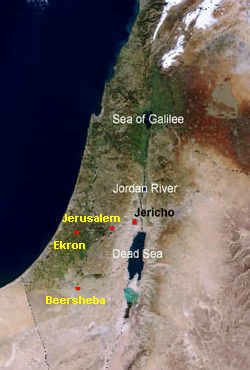
Map with the
position of Jericho, Jerusalem, Ekron,
and Beersheba.
|
The two most important articles of commerce
in the Arab trade are incense from Arabia and the
exportation of olive oil (p.288). Assyria amplifies the
olive oil production, for example with the amplification
of the town of Ekron in Philistine (today the hill of
ruins of Tel Mique) in a plain between the olive slopes
and the coast, with over 100 olive mills which are about
20% of the territory of the town. Ekron is the biggest
known olive oil production center in the old Middle East
with an annual capacity of about 1,000 tons of olive
oil, with exportation to Assyria and Egypt (p.290),
resp. Assyria is giving a part of the commerce also to
Egypt (p.288).
The rising number of camel bones of adult camels since
the 7th century - without the finding of bones of young
camels - seems to be an evidence for the growing Arab
trade (p.288-289).
When the oil mills are excavated Israeli altars with
horns can be found. So it seems as if the Israelites had
worked in Ekron, as deported workers [or as well payed
foreign workers] (p.290).
Fortress construction by
Assyria
Now Assyria also is constructing new fortresses at
the border to Egypt, and they are partly excavated
(p.288).
Densification of population
in reduced Judah - the compulsion for the use of poor
soil
By the influx of refugees from the destructed and
annexed territories the population in the highlands is
rising (p.287).
Jerusalem is forced to use also poor soil now founding a
dense net of farms because the "breadbasket" in the West
was given to the Philistines. The villages are shifted
up to the dry territories in the East and in the South,
with settlements and cultivation of parts of the steep
slopes down to the Jordan Rift Valley and with the
settlement of the bay of Beersheba (p.287). Eventually
this new settlements are performed by forced measures
(p.288).
The settlement in the dry territories and the conversion
of dry soil into fertile soil is the big statal
challenge for the central government. Add to this as a
prevention against the dry season there is installed
also a stock economy (p.291).
King Manasseh: Development of population along
the caravan trade routes
Since king Manasseh the population is growing with a
jump in the bay of Beersheba along the caravan route.
The same happens in Edom which is developing it's
statehood only now. According to the findings - and they
are many - there can be admitted according to
Finkelstein / Silberman that the whole region got their
profit by the Arab trade. More in the South two more
Judean fortresses are excavated:
-- Kadesh Barnea, about 80 km in the South West from
Beersheba, at the biggest oasis between southern Judah
and the Red Sea
-- Hazeva, about 32 km in the South of the Dead Sea
(p.289).
During this period the Arabs in Judah have
good conditions which is confirmed by southern Arab
inscriptions in Judah. According the findings of ostraka
southern Arab writing is used in Jerusalem. Eventually
Arab groups were living in Judah itself. Some scholars
mean on the base of Hebrew seals with southern Arab
names that the wife of Manasseh Meshullemet had been an
Arab woman (p.289). By such a relation a "visit of the
queen of Saba" could be derived which is assigned to
king Solomon in the OT (p.290).
And now there is the shadow of the economic
growth under king Manasseh
-- only few get rich
-- social uprooting and insecurity are rising
-- olive oil gets more profit than normal agriculture
(p.294).
According to Finkelstein / Silberman this wealth also
provokes the dream of an eternal peace (p.294-295).
[And now the religious fanatics with their invended
Moses stories and sins have the problem, that this peace
is made by Assyria].
Manasseh's policy of
religious tolerance
Manasseh's government is supporting the religious
moderate sector. Finkelstein / Silberman presume that
this change was planned since years because Manasseh
only is 12 years old (p.292).
[But the change to a religious tolerance was probably a
necessity to Assyria, and a tool evading more inner
upheavals].
The government of Manasseh is giving back the autonomy
to the countryside which existed before king Hezekiah
making possible a fast reconstruction, and this
reconstruction also is in the sense of Assyria [because
Egypt could invade]. Manasseh has to behave like an
obedient vassal. An intact Judah is a better buffer
state against Egypt than a weak and impoverished Judah
(p.286).
The prophets of the "one god movement" for the
"salvation" of the northern state of Israel may be very
frustrated. King Hezekiah was not at all a savior of
Israel, and they rate king Manasseh as a devil
collaborating with the Assyrian enemy. It seems under
the government of Manasseh had been rebellions and they
were fought brutally (2d book of Kings 21,16), but there
is nothing more known yet. But upheavals of the "one god
propagandists" have probably been (p.294).
The "one god movement" is
preparing new "holy books" - and "Moses" epos is
prepared
The followers of the "one god movement" have waited for
a long time for the death of Manasseh as it seems, and
during this waiting time they prepared new books [books
of Moses 1 to 4 and chronologies of a first Jewish
historiography]. After the death of king Manasseh there
will be a revenge against the wrong tolerance and king
Manasseh shall be demonized (p.294).
There are simply compiled different sources (p.84). The
"one god movement" - according to the Bible researchers
Albrecht Alt and Martin Noth - is compiling many myths
and stories around the Israelite history (p.106).
Archaeological findings and biblical reports contradict
the invented book of Moses (Torah resp. Pentateuch)
(p.35) and the book of Moses is in big parts
taking reference directly to the geographic
situation of the towns how they were constructed in the
8th and 7th century B.C. Because of this all evidence
indicate that the patriarchal texts were written in 8th
and 7th century B.C. (p.51).
The
invention of a Genesis
According to the German Bible researcher Martin Noth
Genesis (1st book of Moses) is a composition of
different stories of the nomads (p.55). The books of
Moses and the chronologies describe almost only
religious conditions. Events of the neighbor states are
excluded (p.297).
[By this method positive events which have their cause
in the neighbor states are regularly presented as
"wonders of God"].
The aim of the "one god movement" is the creation of a
world epos as a collection with historical scriptures,
memories, myths, folk stories, anecdotes, royal
propaganda, prophecies and old poetry, partly original,
partly from copies resp. from elder "versions".
-- this book becomes a folk's book as a mental anchor
for the descendants of the inhabitants of Judah (p.12)
-- with southern Judean and northern Israeli tradition
with the focus of Judah
-- Abraham's alleged altars in Bethel and Shechem
(Genesis 12,7-8) are fixed as the spots of important
centers of cults in the northern Reich of Israel
-- Abraham's alleged altar in Hebron is fixed as the
second important location in the southern Reich of Judah
after Jerusalem (p.57)
-- the books of Joshua, judges and Samuel are rated as
preserved by prophet Samuel in Silo (p.22)
-- the books of the Kings are said to be from the
prophet Jeremiah
-- the psalms are said to be from the faked king David
-- the book of Proverbs and the Song of Songs is said to
be from the faked king Solomon (p.22).
Only in a very late time research is detecting that the
5th book of Moses is written a separate style not
matching with the first four books of Moses, but the 5th
book of Moses was created afterwards. By this the
research is defining the 5th book of Moses and the
latter books as a "Deuteronomistic History" (5th book of
Moses + books of Joshuah, Judges, Samuel and Kings).
Also these texts are referring to the geographic
situation of the 7th century B.C., and also according to
archaeological findings they are written mainly in the
7th century B.C. (p.25) in the southern Reich of Judah
(p.26), in Jerusalem (p.59-60).
The myths about the kings of David and Solomon seem to
be present yet and are integrated into the books of the
Kings of the OT (p.160-161).
[With this the authors fake a big kingdom under David
and Solomon, probably admitting that this could never be
controlled. Or there are presented myths of other kings
as events under David and Solomon].
681-669 B.C.
More documents about Manasseh as a vassal
Under the successor of the Assyrian king
Sennacherib, Esarhaddon
[ruled 681-669 B.C.] Manasseh's Judah is rated in the
Assyrian sources ad a supplier of building material, as
21 other vassal kings (p.286).
And there is not only building activity, but also the
expansion to Egypt:
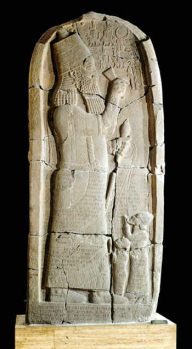
 Esarhaddon,
profile. Esarhaddon is leading the defeated with
a nose ring Esarhaddon,
profile. Esarhaddon is leading the defeated with
a nose ring
|
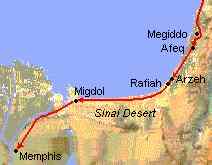
The military campaign under Esarhaddon to Egypt
down to Memphis
|
Assyria's
biggest extension
|

 Assyria's
emperor Ashurbanipal who had Egypt up to Thebes
occupied, profile. This relief is in the British
Museum in London. Assyria's
emperor Ashurbanipal who had Egypt up to Thebes
occupied, profile. This relief is in the British
Museum in London.
|
669-627 B.C.
Assyria under
Ashurbanipal
Under the successor of Esarhaddon, Ashurbanipal
(Greek: Sardanapal), Manasseh is acting with
gifts and as loyal friend helping the occupation
of Egypt - according to Assyrian sources
(p.286).
652 B.C.
Egypt: Assyrian
invasion up to Thebes - plundering Susa
[web03]
OT claims:
There is a description in the OT that Manasseh
is seized by Assyria in Babel (2d Chronicle
33,11), but in other sources that is never
mentioned (p.286).
|
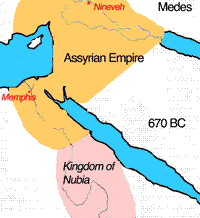
Map: Assyria conquering the lower part of Egypt.
Only Upper Egypt (Nubia) keeps to be Egypt |
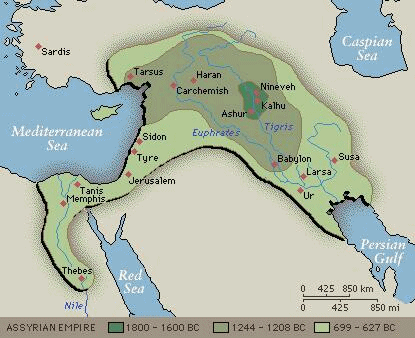
Assyria under Ashurbanipal: Egypt is occupied up
to Thebes. This is the maximum of extension of
the "Fertile Crescent"...
|
The downfall of Assyria
According to Finkelstein / Silberman the downfall of
Assyria is provoked by the continuing attacks on
horseback by the tribes of the Scythes at the northern
border. Add to this there are continuing upheavals in
Babylonia and in the East in Elam (p.303).
[Addition:
The overextention of the borderlines in Egypt provokes
the collapse of the Assyrian Reich. The northern border
is neglected and vulnerable. The biblical saying is:
"The last will be the first". This overextention of
borderlines by big empires and their following ruin is a
general political reality].
664-610 B.C.
Egypt under Pharaoh Psamtik
I reorganizing Egypt
and unifying the nobles under his leadership (p.303)
Psamtik I receives the order from Ashurbanipal to unify
the Nile Delta which is split in several Assyrian
princedoms. He is executing this order with a strong
army of Egypt and Greek soldiers [web04].
since 660 B.C.
Assyria is weakened by a
rebellion in Babylonia and Elam
[web05]
656 B.C.
Egypt can kick out Assyria
- and there is a new nationalism in Egypt
(p.302)
Psamtik I is succeeding unifying Lower and Upper Egypt.
[web06]
Now Egypt get a great political revival, with adherence
of "great" Pharaohs of the past (p.302). Psamtik I can
solve Egypt from the Assyrian domination step by step
(p.302-303) extending his territory to parts of the
Fertile Crescent because Assyria cannot keep it's power
there (p.303). Step by step the "Assyrian century" is
coming to it's end now, and the Bible is concealing all
this completely (p.304).
[But also Egypt will overextend it's
borderlines...]

Herodotus, portrait of
another great liar: According to archeology
his descriptions of an Egypt siege of Ashdod
is an absolute invention. Not one single
finding of a fight could be found...
|
|
New territorial
expansion of Egypt
Egypt is pursuing Assyria. So,
Assyria is retreating from big parts of the Fertile
Crescent (p.303).
According to Greek historian Herodotus
Psamtik I is said having sieged the town of Ashdod for
29 years. According to archeology there is not one
single trace of any destruction there, and it seems that
the takeover of power there had been performed without
any fight. The description of war of Herodotus seems to
be an sensational invention for making more money with
it (p.303).
Judah is not important for
Egypt - and the "one god movement" can prepare it's epos
of Moses
|
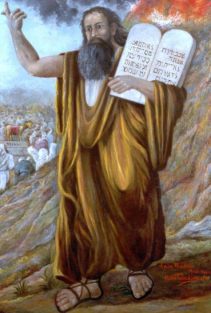
 Patriarch
Moses with written tablets, a painting with
much fantasy without any confirmation by
archaeological findings Patriarch
Moses with written tablets, a painting with
much fantasy without any confirmation by
archaeological findings
|
The little kingdom
of Judah has no significance for Egypt and hardly is
controlled in the beginning. This state without control
is a paradise for the prophets of the "one god movement"
prising their God. They mean that the "salvation" of the
ex northern Reich of Israel would be possible now.
Without control a dictatorship of the "one god movement"
also a religious cleansing is possible (p.304).
The "holy books" with it's epos of a
"Moses" should revive new Jewish dreams again and a big
national fight should begin against Egypt and the
Pharaoh (p.304).
These propaganda texts of the "one god
movement" against their neighbors (4 books of Moses and
the books of Kings with absolute faked claims against
Egypt and the Mesopotamian Empires) are prepared. The
"one god movement" only is awaiting the death of king
Manasseh...
642-640
Kingdom of Judah: Death of king
Manasseh - successor is king Amon
OT claims:
-- king Amon is said having tolerated
the wrong belief
-- after 2 years Amon is said having
murdered by a conspiracy
-- and now there was a revenge of the
population murdering the murderers, and by these events
all social and economic elite of the country was
murdered - according to Finkelstein / Silberman
-- Amon's 8 years old sun Josiah is
said having proclaimed as the new king now (p.295).
640-630 B.C.
Egypt conquering Middle East
Assyria has to give up Egypt,
Philistine, Phoenicia, and the territory of the ex
kingdom of Israel. Egypt troops are continuing their
campaign (p.83).
[Egypt wants to create an Egypt
Fertile Crescent...]
Archeology can prove a growing Egypt
influence in the Fertile Crescent for the time of the
end of the 7th century B.C. Pharaoh Psamtik I can
reinstall the traditional buffer state of Canaan against
the military Empires in the Mid East and in his
inscriptions he indicates his power up to Phoenicia
(p.303).
At the same time Egypt profits of
Canaan with important agricultural territories and
important trade routes (p.304).
Sennacherib, report of the military campaign against Judah written in a clay prism. Today this is in the British Museum.
Esarhaddon, profile. Esarhaddon is leading the defeated with a nose ring
Assyria's emperor Ashurbanipal who had Egypt up to Thebes occupied, profile. This relief is in the British Museum in London.
Patriarch Moses with written tablets, a painting with much fantasy without any confirmation by archaeological findings

















